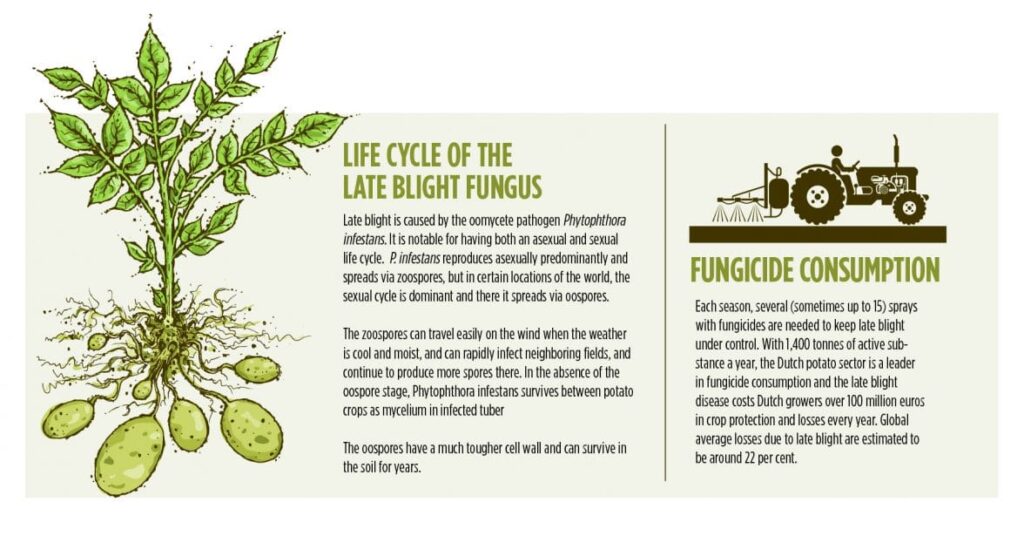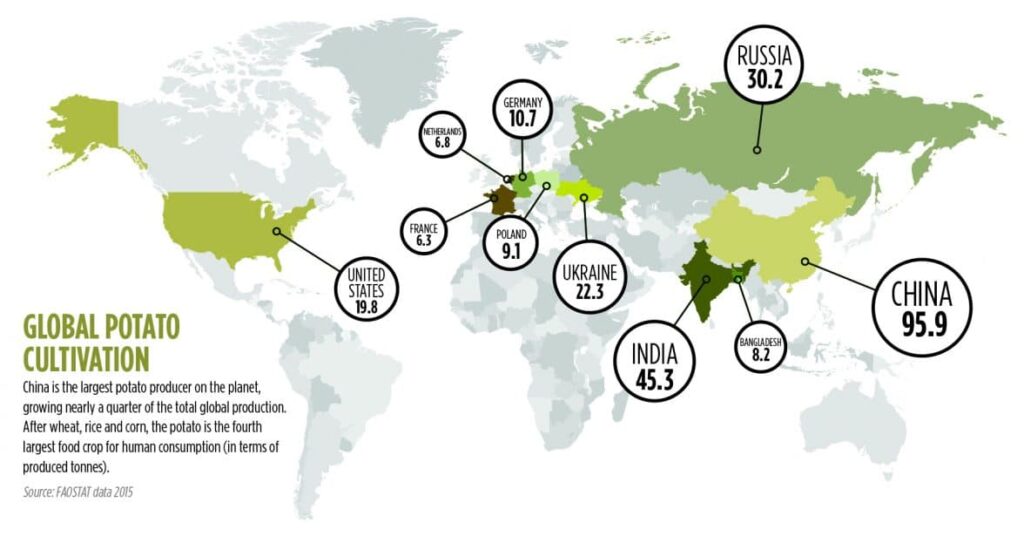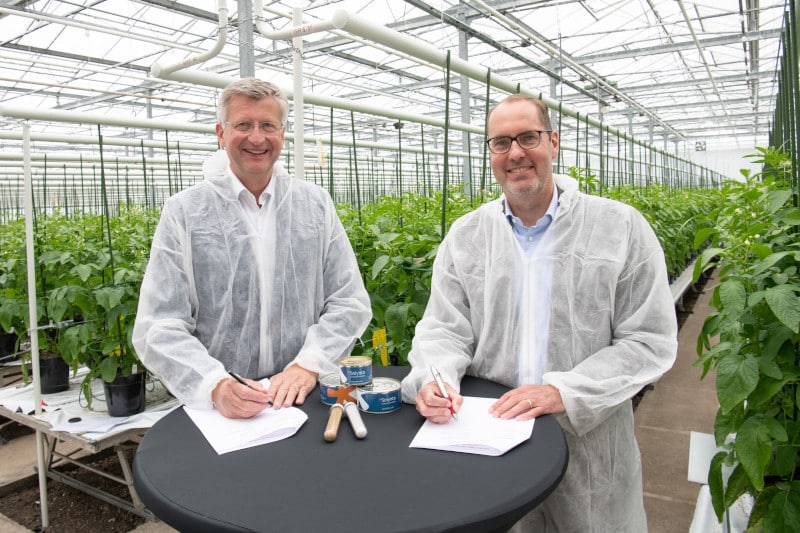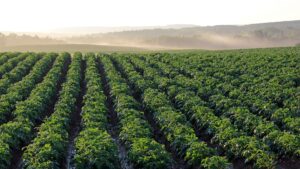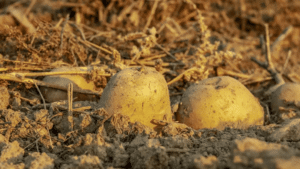By: Arno van ’t Hoog
Using Wageningen gene technology, potatoes can now be produced which require very little pesticide to stay free of potato blight. Resistant potato varieties could be a reality within five years, but genetic modification is a sensitive issue and a decision in Brussels is anxiously awaited.
The pathogen Phytophthora infestans, which causes potato blight, is literally everywhere. The infectious water can be in the soil in any area where potatoes are grown. This single-celled pathogen can reproduce incredibly fast and is capable of destroying a crop in a matter of weeks.
To prevent this, Dutch farmers spray their potato fields 10 to 16 times a season with fungicides. As a result, potato cultivation is responsible for half of all pesticides used in Dutch agriculture. It also costs farmers €600 euros per hectare of potatoes. Overall, Dutch farmers spend more than 100 million euros every year on protection against Phytophthora, commonly referred to as potato blight. Worldwide, crop losses due to Phytophthora are estimated at up to 10 billion euros a year.
Last September saw the completion of a long-term project in which Wageningen researchers developed potato varieties that are resistant to potato blight. Genetic modification was used to insert genes from wild Central American potato species in these varieties. Phytophthora scarcely has any effect on them; in field trials, it proved possible to reduce the use of pesticides by 80 per cent. The genetically modified potato plants are almost identical to the traditional varieties. “Except when you have experimental plots where no pesticides have been used: then the upgraded varieties look a lot different,” says project manager and agrosystems researcher Anton Haverkort from Wageningen UR. “They continue to grow whereas the standard plants next to them rot away. After a couple of weeks, the trial field looks like a green and brown chessboard.”
It is more than 10 years since a delegation of civil servants from various ministries visited Wageningen in search of projects on the application of genetic modification in agriculture. Haverkort: “There was a feeling in government circles that the Netherlands was starting to lag behind. No other country earns so much from seeds, seed material and flower bulbs, but we were doing nothing with genetic modification. It was almost inevitable that Wageningen would come up with a project focusing on potatoes and Phytophthora,” says Haverkort. It is the most important Dutch arable crop and potato blight is a major problem.
Furthermore, Wageningen professor Evert Jacobsen had been working on genetic modifications of potatoes for a while and he had already discovered a few Phytophthora- resistant genes. “So we could get off to a flying start; we knew that we would be able to produce a potato with lasting resistance within 10 years.”
The proposal soon got the go-ahead with a grant of 10 million euros from natural gas revenues. And so the DuRPh project was born (the Dutch acronym stands for ‘lasting resistance to Phytophthora’).
A new form of genetic modification was deliberately chosen for the DuRPh project: only species- specific potato DNA was used to make the plants resistant. That meant genes from wild potatoes that could also be crossed with modern potatoes through pollination.
Traditional Plant Breeding
Genetic modification that remains within the species is termed cisgenesis, as opposed to transgenesis in which DNA is used from a different species or bacteria. Transgenic maize and soya beans with genes from bacteria and viruses have given rise to many questions and much debate over the past 20 years about the risks to humans and the environment.
Cisgenesis avoids some of those objections as the result is much closer to the outcome of conventional plant breeding. Haverkort: “By using cisgenesis, we wanted to keep a link with traditional plant breeding. Cisgenesis is somewhat trickier and more expensive because selecting the right modified plants is a little more difficult.”
In the course of the project, the researchers tracked down 15 resistance genes in wild potato species. Those genes enable a plant to recognise Phytophthora, causing a rapid immune response on first contact, so that the pathogen is unable to get a foot in the door. But resistance is never permanent.
Organisms are constantly evolving and so new strains of Phytophthora could emerge over the years that even resistant plants are unable to cope with. The potato plant no longer recognises its attacker, so the infection can take hold. Breaking through the plant’s immune system is a great deal harder, however, if it has multiple resistance genes. That is why the researchers created a chain of two or three different resistance genes and inserted them in the DNA of the potato cells. The plants that grow from these cells undergo extensive testing, not just for their resistance to the disease but also to check that they are similar to the original variety in all other respects. This method was used to create Phytophthora-resistant versions of three potato varieties — Première, Désirée and Aveka. Field trials produced convincing results. This does not mean pesticides are completely redundant, says Haverkort. “It would be possible to do without pesticides entirely, but when the foliage turns yellow in the autumn, levels of resistance are low too and Phytophthora could get an opportunity to attack. Then it is a good idea to spray the plants once or twice. It is also possible that Phytophthora will gradually evolve and therefore bypass one of the resistance genes; that is another reason for spraying occasionally,” says Haverkort.
There will always be a need to closely monitor developments in Phytophthora, just as there will be for switching potato variants whenever Phytophthora looks like bypassing a resistance gene. You need plenty of substitutes on the bench, so to speak: the same potato variety but with a different combination of resistance genes every time. In this way, Phytophthora is given little opportunity to adapt to the new combination of genes. If it looks as if a resistance gene has been cracked, that variant will not be used for a few years. The Phytophthora strains that cracked the resistance will gradually lose that property again. If the resistance gene is brought back into action in the field a few years later, it will therefore be effective once more. Haverkort: “You can make sure that you retain control of Phytophthora and prevent your resistance genes from becoming worthless by monitoring the situation and alternating 15 resistance genes in various combinations.”
Impressive sight
“I visited the trial fields and they were an impressive sight,” says Tanja van Oers, the chair of the DuRPh supervisory committee and a senior policy officer in the Plant Supply Chain and Food Quality Department in the Ministry of Economic Affairs. “You see the resistant potato plants growing with hardly any pesticides while the standard varieties die off. The ministry is very enthusiastic about what has been developed within DuRPh,” says Van Oers. “It is a good example of a technique that is contributing to food security and sustainability, and it can be applied using the existing table potato varieties. So you could make varieties resistant within a few years. This also fits in with one of the ministry’s goals, which is to reduce the use of pesticides.”
Sharon Dijksma, the former State Secretary for Economic Affairs, attended a talk by the researchers, says Van Oers. She said then that she hoped the private sector would continue with the application of cisgenic techniques in producing resistant potato varieties. Van Oers: “The development phase was funded by the ministry. Now it is up to the private sector to take this further. The technology has advanced far enough to enable cisgenic potato varieties to be brought onto the market quickly. We want to hear from companies how they intend making use of these results. We can appreciate that Wageningen would like to continue with this research; perhaps this will be possible in collaboration with the private sector. You could, for instance, consider funding through the top sector system, with the government supplying part of the funding but with the private sector taking the lead.”
But if cisgenesis is to become truly appealing to the private sector, for example to potato breeding companies, then it will need to lose the GMO (genetically modified organism) label, says Robert Graveland, head of R&D at potato breeding company HZPC, the largest producer of seed potatoes in the Netherlands. The company from the town of Joure exports seed potatoes to more than 80 countries. Graveland sees major benefits from this technology, but so far HZPC is only applying it in a research project; it is definitely not using cisgenesis in breeding new varieties.
After all, the company’s website has a clear non-GMO statement stating that all the varieties it supplies were developed without the use of genetic modification. “Our customers want us to state our position clearly,” says Graveland. This shows how the potato sector views genetic modification, and as long as cisgenesis is seen as a form of genetic modification, that method will not be an interesting option for plant breeding companies. “Companies are also saying that the approval criteria are currently preventing them from using cisgenesis,” says Van Oers. Because the technology is classified as a GMO technique, field trials and risk assessments are needed before a cisgenic variety can be brought on the market. “We hope that the outcome of an analysis by the European Commission will help in that regard.” The Commission is working on a judicial investigation of the application of legislation to new breeding techniques. That may lead to a new classification for cisgenesis with less stringent procedures than for other GMOs. In 2012, the European Food Safety Authority (EFSA) already concluded that the risks run by consumers from cisgenic plant varieties are comparable to those from plants produced by traditional plant breeding.
But early this year, a coalition of European environmental and consumer organisations, including Greenpeace and Friends of the Earth, published an open letter calling on the European Commission not to make an exception for cisgenesis. They consider the risks to be higher and think that these crops should continue to be subject to the same tests and labelling requirements.
Opponents have said for a while that inserting genes from the same species can still have similar unexpected and unpredictable effects to the effects from modification using genes from a different species. An inserted gene ends up in a random position in the plant’s genetic material and can therefore inadvertently disrupt processes, which could lead to the creation of toxic or allergic substances. It is therefore open to question whether an end will soon come to the debate on the assessment of cisgenesis, which has been going on for years.
Launching New Varieties
“We really need a European ruling like this, we can’t start doing our sums until we have it,” says Graveland from the potato breeding company HZPC. “If there is no change in the regulations and you are required to build up dossier with field tests and risk assessments that will make things very difficult. Then launching a cisgenic potato variety will take 10 years and cost tens of millions of euros. We could never recoup that investment. So our decision as a company on whether to add cisgenesis to our suite of techniques depends crucially on what the EU decides.”
Graveland has been a member of the DuRPh supervisory committee since 2006. He says that the project has already produced a great deal of knowledge that can be put into practice in potato breeding practice quite apart from cisgenesis. Thanks to this research, plant breeders now know how best to combine resistance genes. Now they can use DNA screening to select parent plants according to their genetic profiles and then cross-breed them. In this way, varieties can be produced with new Phytophthora resistance genes using conventional breeding methods.
According to Van Oers, this application is where DuRPh has added value for organic farming too. “Genetic know-how from the project helps plant breeding regardless of whether cisgenesis is used. There is more than one way of achieving the same end result. The nice thing was that the organic sector had extensive contact with the research on resistance to Phytophthora.”
Although conventional breeding methods can also produce resistance to Phytophthora, that route takes longer, about 10 to 15 years, says Graveland. Cisgenesis offers another advantage to plant breeding companies aiming to corner the conservative potato market. Potato growers and food processing companies, such as the manufacturers of French fries and potato chips, are used to potato varieties that produce tubers with a known shape, starch composition and frying properties. “They are therefore not keen on switching to a new variety. If you use cisgenesis, you are only altering the resistance; all those familiar varietal properties remain the same. That is a real advantage when compared with traditional plant breeding.”
This is precisely why the Belgians want to use cisgenesis to create a Phytophthora resistant Bintje. Bintje is a popular French fry potato in Flanders but this variety is highly susceptible to Phytophthora. Three Flemish institutions–Ghent University, the life sciences research institute VIB and the agricultural institute ILVO–want to change that.
“In 2011 and 2012, we got some experience through field trials in Wetteren using plants from the DuRPh project,” says René Custers from VIB. “I think DuRPh has really got the ball rolling; that project is at the basis of everything that is possible at present. We now have the resistance genes, the knowledge and the means to make Bintje resistant for the long term. We don’t need to go looking for new resistance genes; we can build on the research done in Wageningen. If everything goes according to plan, the first field trials of the upgraded variant of Bintje will take place in 2017 or 2018,” says Custers, who studied Molecular Sciences in Wageningen. “We want to create a Bintje with a few effective combinations of resistance genes. This will be followed by a development process with field trials and then there will have to be a commercialisation process started by a potato breeding company.”
People in Flanders are also waiting anxiously for the decision by the European Commission on cisgenesis. Custers: “Even if cisgenic potatoes continue to be covered by the existing rules, it is debatable whether the same battery of safety tests will have to be carried out for these potatoes as is required for many transgenic crops. I hope that this will prompt a new debate because Phytophthora-resistant potatoes are a very important product. Resistant varieties can also be obtained using traditional methods but these still need to prove their worth. And they will not have a combination of multiple resistance genes, which makes it more difficult for them to retain their resistance in the long term.’
The Sainsbury Laboratory in Britain, which published an article last summer together with Wageningen UR researchers about the discovery of a new resistance gene, has also started a project to make an existing potato variety resistant to Phytophthora using cisgenesis. The technology is now sufficiently advanced that both Belgium and Britain will be able to launch a resistant variety within four to five years, estimates Haverkort.
Tubers Harvested
There are no signs as yet of a comparable Dutch follow-up project. It is not clear what will happen to the potato variants from the DuRPh project. The tubers were recently harvested but whether they will be planted next year depends on the funding. Continuing to cultivate them would cost about 30,000 euros a year. A grant application was rejected by the Ministry of Economic Affairs, although retaining the potato variants is one item in the discussions that the ministry is holding with companies about follow-up research.
Haverkort would like to keep the DuRPh variants for monitoring and demonstrations. “We can let them grow as small plants in the lab, only then it takes two seasons before they can be cultivated in fields again. But we still have four months to find a solution before the seed potatoes start to rot.” Despite this open end, Haverkort sees the results from DuRPh mainly as the perfect outcome. “We really got the hang of the scientific and technical aspects. The project is not a semi-failure just because the results are not yet being applied in the agricultural sector. Of course it would have been wonderful if our research had led to a change in the law, but that was not the aim. That would have been a side effect and this is something that will still take some time.”
Source: Wageningen World, magazine of Wageningen UR



